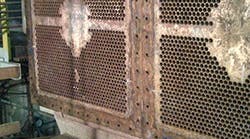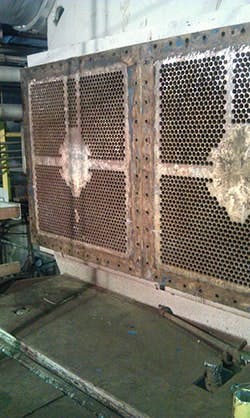Don’t Foul Up Your Water Treatment Program
Water treatment is a critical issue at many chemical plants because process, cooling and makeup water play important roles in operations. Poor water treatment chemistry usually induces corrosion, scaling or fouling of equipment and systems that, in turn, can cause equipment failure and sometimes even plant shutdown. Such incidents may incur enormous costs and, even more importantly, may jeopardize employee safety. Yet, time after time, we’ve observed requests for proposals (RFPs) for water treatment programs that are noticeably incomplete or based on outmoded ideas. So, here, we’ll provide an overview of important items that should be in an RFP to allow the water treatment vendor to select the correct program(s).
At existing plants, RFPs for modification or change to water treatment programs may arise for a variety of reasons, including performance concerns, service issues, reaching the mandatory time period for a rebid, procurement initiatives or cost evaluation. The driver for the RFP will greatly influence the effort required by the vendor in preparing a bid, and may lead some suppliers to give minimal attention or not bid the project at all if they don’t see a benefit. This underscores the need for clear communication to achieve the best results from the bid process.
[callToAction]
Do The RFP Right
Very commonly for both existing and new projects, suppliers receive an RFP with scant data regarding the actual technical details of the project. Indeed, there have been cases where a large RFP mainly consists of front-end legal descriptions with insufficient technical detail. So, let’s look at some deficiencies that afflict RFPs and the bid process, and outline some necessary information for a proper evaluation.
Figure 1. Failure of just one of the numerous tubes used can contaminate the condensate. (Water box removed to show tubes.) Source: American Exchanger Services.
Water quality data. Comprehensive chemistry data for makeup, cooling and process water are extremely critical for determining proper chemistry programs and also for selecting equipment type and size, especially at new plants. Often, however, RFPs will arrive with just partial chemistry data, sometimes only from a single analysis. Worse still, we’ve encountered RFPs and design engineers who simply say, “Design to standard water.” The only thing standard about water is that it’s wet. Analyses should show any trends in water quality over time and contain a full list of major cations and anions, along with minor elements/compounds, including metals, organic carbon, pH, suspended solids, nitrogen-based species and others. For makeup water, its source obviously will significantly impact the quality and impurities that need treatment. Increasingly, new plant designs are moving away from fresh water supplies. Municipally treated wastewater (reclaim water) is becoming a popular alternative; compared to fresh waters, it typically contains markedly higher concentrations of ammonia, nitrites/nitrates, organics, phosphorus and suspended solids, which, if not treated, can cause serious problems in cooling systems and other locations.
Process water quality data, including readings from the steam generators and condensate return, where applicable, also are important. Impurities can enter these streams from many sources. For example, heat exchangers that operate with process fluid at a higher pressure than the steam heating supply may introduce a variety of contaminants to condensate. Turbine exhaust steam condensers are a common location of impurity ingress; they typically contain thousands of tubes (Figure 1) and even a single tube failure allows cooling water to enter the condensate.
Continuous online monitoring of condensate and boiler water chemistry is an absolute must to prevent serious to potentially catastrophic damage in steam generators.
Up-to-date plant water balance. Every new plant invariably has a water balance to outline process flows throughout the facility. However, these flows often change considerably over the life of the plant as new equipment and processes are added and others retired. An accurate up-to-date water balance is critical for evaluating and modifying treatment programs. Frequently, establishing current flow volumes requires ultrasonic flow measurement. A problem that plagues many plants, apart from the water balance, is location of underground piping, regardless of whether the pipes contain water or other fluids. Too often, plant personnel must rely on the memory of long-time employees because installation of additional underground piping was never properly documented.
Specification sheets for all major equipment to be treated. Knowledge of equipment details, size, type, internal components, operating parameters, etc., is crucial for selection of chemical treatment programs. This applies to many systems in the plant. Here’s a rundown of some key elements and necessary details.
1. Makeup water treatment system (which may include, but isn’t limited to, pretreatment screening devices, settling basins, clarifiers, micro- or ultra-filters, reverse osmosis units and ion exchangers):
• inlet water temperature range; and
• historical raw water analysis.
2a. Cooling water systems (whether once-through or cooling-tower based):
• flow rates; and
• system materials, including heat-exchanger tube materials.
2b. Cooling-tower based systems:
• tower size and materials of construction;
• tower type (typically counterflow or crossflow, mechanical draft);
• system volume;
• chemical treatment (current program, including scale/corrosion control chemicals and biocides used, as well as treatments not allowed); and
• typical operating data, including cycles of concentration (COC) being maintained in the tower, temperature difference across the tower at various seasonal conditions, and seasonal recirculating rates.
3. Process water and closed cooling water systems:
• heat exchanger and piping materials;
• heat exchanger operating temperatures; and
• basic chemistry of process fluids on the other side of the heat exchangers (to identify what impurities a leak would introduce into the condensate return).
4. Steam generators:
• type and fuel source;
• operating pressure;
• current condensate/feedwater and boiler water chemical treatment programs; and
• description of the condensate return system.
5. Waste stream discharges:
• current plant National Pollutant Discharge Elimination System (NPDES) permits;
• any permitting of particulate matter less than ten microns (PM10) in cooling tower air exhaust; and
• any cooling tower blowdown limitations.
Also important is a history of equipment upsets or failures to alert the water treatment supplier to conditions that have caused problems in the past. Due to the harsh conditions that may exist in some systems such as steam generators, chemical treatment often can be described as “walking on the razor’s edge,” where even seemingly slight upsets may have major consequences.
Figure 2. Reducing agents induce flow-accelerated corrosion that can cause catastrophic failures. Source: Steve Shulder, Electric Power Research Institute.
Vendor Interaction
We have been involved in numerous pre-bid meetings where the operating company invited all the vendors to one meeting and scheduled perhaps just a couple of hours at most for equipment and system inspection. The motive is to save costs — but such an arrangement hampers knowledge transfer. For starters, placing vendors together inhibits the airing of questions and comments because suppliers want to avoid tipping off the competition. Much better information exchange will occur if vendor visits are scheduled individually. Also, make time available for the supplier to meet with plant operators and technical personnel and to tour the systems that require treatment.
Some actual examples of what not to do include:
• giving suppliers ten-day notice to inspect 35 plants;
• providing two-day notice to be at the site for a plant walkdown; and
• not doing a walkdown but instead simply handing suppliers a makeup water sample and telling them to design a program based on that analysis.
Another common mistake is not allowing the vendor to use its expertise.
Many times, an RFP will arrive in which the owner or owner’s engineer has established control parameters without giving proper, if any, thought to the technical details involved. This applies to equipment as well as chemicals. A classic example we frequently observe is an RFP that specifies an elevated COC for the cooling tower. Apparently, the designers believe that a high COC provides environmental benefits because of reduced blowdown. They don’t realize that most of the water loss from a cooling tower is due to evaporation and that as the COC increases much above six or so, the water savings in the blowdown become minimal. On the other hand, chemistry control gets much tougher as COC rises.
Another example, one particularly prevalent in the power industry, is that of RFPs blindly calling for injection of an oxygen scavenger (reducing agent) into the condensate/feedwater systems of the steam generators. Unless the feedwater system contains copper alloys — and virtually no modern combined cycle units with heat recovery steam generators (HRSGs) do — this chemistry is outmoded. In fact, it’s long been established that reducing agents induce a phenomenon known as flow-accelerated corrosion (FAC) in feedwater piping, economizers, attemperator piping and low-pressure circuits of HRSGs (Figure 2). A number of FAC-induced failures have caused fatalities over the last three decades.
Proceed Properly
We have highlighted some of the issues and omissions that undermine getting the most appropriate water treatment programs. Following the pointers presented here will help your water-treatment vendor come up with the best option for your site. The old mindset that “water is water” can lead to major failures at industrial plants.
KEVIN BOUDREAUX is a member of the technical staff of ChemTreat, Glen Allen, Va. BRAD BUECKER is a senior technical publicist for ChemTreat. Email them at [email protected] and [email protected].




